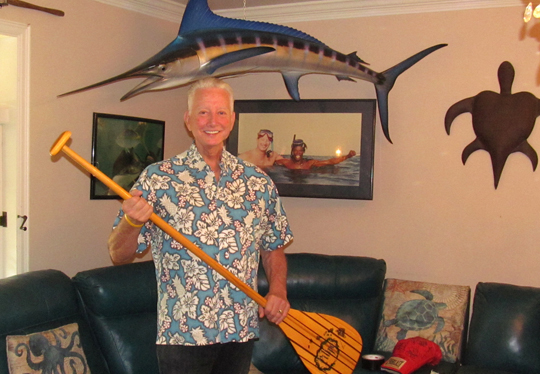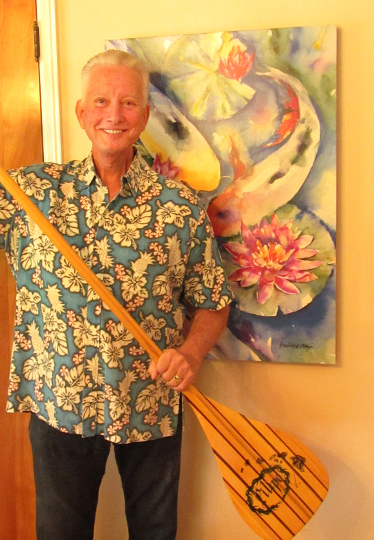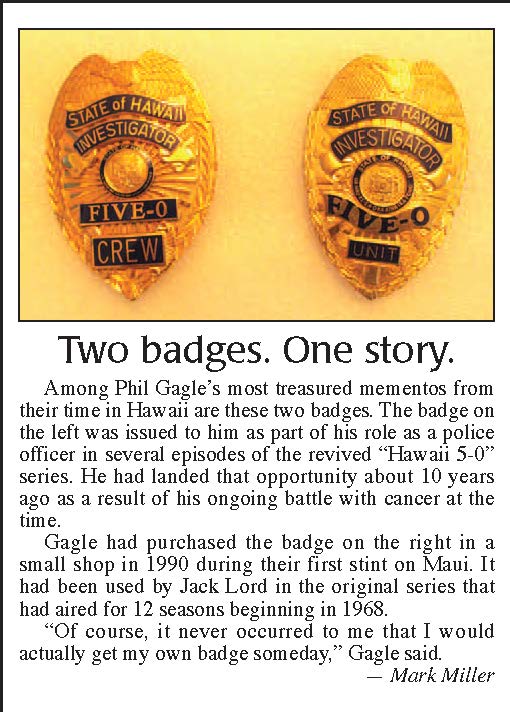Phil Gagle worked with the shop-owners and artisans of Lahaina
By MARK MILLER
The images of the total devastation of the small but historic town of Lahaina on the island of Maui evokes emotion for anyone who has visited that area. But for Bluffton’s Phil Gagle, it’s much more than that.

“The horror of it wakes me up every day,” he says.
Gagle and his wife Cindy lived on the Hawaiian island for more than a dozen years at three different times. During their final chapter there, from 2008 until 2015, he served as the chair of the Maui County Commission on Culture, headquartered in Lahaina.
“So I was there pretty much every day,” the 1970 graduate of Bluffton High School said. “I probably know Lahaina’s streets better than I know Bluffton’s.”

The commission’s task is to promote the arts and culture of Maui County, which encompasses three inhabited islands: Maui, Lāna’i and Moloka’i.
“But Lahaina has always been essentially the cultural center,” Gagle continued. It was the island’s first capital and has a history as a whaling village. He compares it to Nashville’s role in Indiana, which he describes as “an arts community off on its own that has always had hippies and artisans.”
Hence, Gagle knows many of the people directly affected by the tragedy.
“I was in every one of those small stores and art galleries in the downtown area,” he said. “Many times. I worked with those people.”
He laments the loss of the works of art in the stores, but mostly, of course, he mourns the loss of so many of the citizens. As of Saturday morning, the count of confirmed dead had grown to 114.
“And there will be more, maybe hundreds,” he shared.
He notes that there is hope that the famous 150-year-old banyan tree in the courthouse square will survive the fire, giving the community a fitting symbol of re-birth.
“But it’s going to be so difficult for them,” he said. Part of him wonders, at least, if the small town and community can be fully rebuilt and the “magic” that was Lahaina can be recaptured. He notes the difference between what state and Maui officials are focused on at this point.
“The state is talking about rebuilding,” he observed, “but if you listen to the locals, they are talking about taking time to mourn, to heal.” What he fears most are “predatory developers” who will make offers to buy the local people out. The fire could also have a major impact on the choices of Hawaii’s young people. Many of them have found careers on the mainland. “I’m afraid this will drive many more away from their islands,” he said.
Gagle’s commission work was a volunteer community service he sought out while teaching four classes in political science at the University of Hawaii’s Maui campus. He had given up his career in politics and lobbying to follow Cindy’s career of managing oceanside resorts. They had met in 1989 when she was managing the Esmeralda Resort in Palm Springs, Calif., and he was looking for accommodations for a political convention.
He earned his masters degree at Arizona State in order to teach, something he was able to do at various stops in his wife’s career in Arizona, the Bermudas and Hawaii. During this final time in Hawaii, she was in charge of all of the Fairmont properties on the islands.

When what is widely known as “the Cline home” on River Road came on the market 13 years ago, the Gagles purchased it for retirement. Phil Gagle has been living there in-between lengthy visits to California where Cindy has been wrapping up her career.
Phil Gagle is now cancer-free after being diagnosed in 2011 with stage-four cancer on the base of his tongue. That ordeal has been previously documented by The News-Banner, as has his political career that began when he dropped out of Indiana University to work full time on Gerald Ford’s 1976 presidential campaign. He would later return to get a degree in political science.
“I talked with the guy who bought our home on Maui,” he continued his story. The home is located on a golf course on Maui’s south shore, about a 30-minute drive from Lahaina. “He owned a couple businesses in Lahaina,” he said. “Lost everything.”
He can relate the island’s history, its uniqueness, its diversity, but also its eccentricities and faults.
“In many ways, the government is a ‘good old boy’ network,” he explained, referring to the emergency management official who chose not to sound the tsunami sirens to alert people of the danger.
“That jerk” was “probably the cousin of someone,” and not hired for his experience or competency, he is sure. While the system was tested once a month while they lived there, “people know that if it is sounded, they need to react to something, and for goodness sakes, they would have looked out the window and seen the smoke and they would not have run into the fire. That’s ridiculous.”
Gagle has kept in close contact with Cliff Libed, a native Hawaiian who was his vice-chair on the commission. Libed is currently in Seattle visiting grandchildren, “but he has a place in Maui and will be going back,” Gagle said.
He is hopeful that people will continue to visit the islands and that Lahaina people can get jobs elsewhere while the town recovers.
“It’s just a very, very special place,” he said often.
miller@news-banner.com



